Chess no. 386
PHILIDOR
Anyone who runs a `mixed' chess column, i.e. one which attempts to cater for players and problemists, is aware from his correspondence of the mixture of bafflement and contempt with which the player is apt to greet the problem. `Such a position would never arise in play and if it did Black would long since have resigned unless both players are mentally deranged' is a fair summary of the basic position of the player. The next stage beyond this is to accept that.the problem position is not meant to be realistic, but is just a puzzle, i.e. that the interest lies solely in the composer's ingenuity in hiding the method of solution and the solver's attempts to unravel the mystery. This is a major step forward, because the puzzle element is an integral part of a problem and it is a great merit in a problem and in the solver's enjoyment and feeling of achievement that it should be difficult to solve. Indeed, in the problems of the last century (such for example as Sam Loyd's, Klett% or some of Shinkman's) difficulty was by far the most im- portant element; some of Klett's four and five movers were said to be so hard that no solver succeeded in doing them.
However, difficulty—i.e. the puzzle element—is by no means all there is to a problem and nowa-
days most composers would relegate it to a minor place. The claim that is made for chess problems —and I think with justice—is that they are a minor art form, that the pleasure they give is, partly at least, an aesthetic one. This they do somewhat as music does; the simple pleasure of finding the correct solution is perhaps analogous to the plea- sure one gets from direct enjoyment of the sound in music—when one fully understands a problem then one gets, of course in a much smaller field, the intellectual enjoyment that a musician gets from the development of a theme or themes in a com- plex work.
This week's problem illustrates one of the fun- damental themes in chess problems—the idea of waiting moves and changed mates. Suppose White could leave the position essentially as it is (add, for instance, a White pawn on K R 4 and let White play 1 P –R 5) then any Black move would be fatal. For example, if Black were to play 1 . . . R – K 6 White would reply 2 Kt –Kt 3 mate or
if 1 R –K 8; then 2 Q – Q 3 mate. In the most primitive form of 'waiter' or 'complete block' White would have such a waiting move, would play it and Black would have to commit suicide; this is quite interesting first time you see it—after that it is dull. In Funk's problem, however, you will find that there is no waiting move—anything that tries just to maintain the status quo allows Black to escape. The true answer still makes no threat, but it abandons all the existing mating
possibilities (the so called 'set' mates) and replaces them by a- completely new collection of mates. To see and enjoy this is to begin to understand what problems are about; if you do, and want really to know the problemist's art, read Chess Problems: Introduction to an Art (by Lipton, Matthews and Rice; Faber 42s).
Black White 3 men
H. E. Funk (3rd Prize, Good Companions, 1922). White to play and mate in two moves; solution next week.
Solution to no. 385 (Mansfield): Kt – K 4, threat Kt X P. 1 . . . Q – Kt 6 or B 7 ch; 2 Kt x Q- 1 . . Q x B; 2 Kt (4)– B 5. 1 . Q X 13;
2 Kt (4)– Q 6. 1 . . . 'B x P; 2 Q –Q R 2.1 . . • Q X Kt; 2 Q X Q. Beautiful set of self-pinning defences.






































 Previous page
Previous page